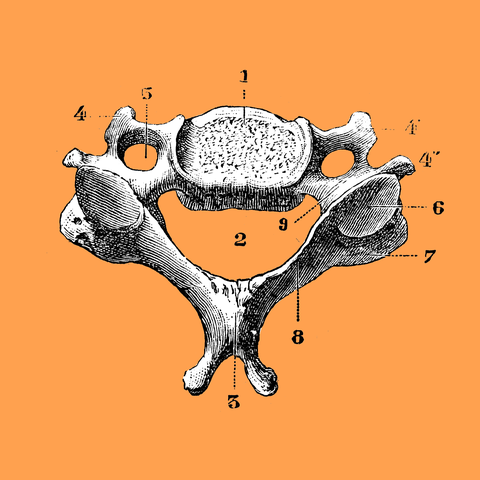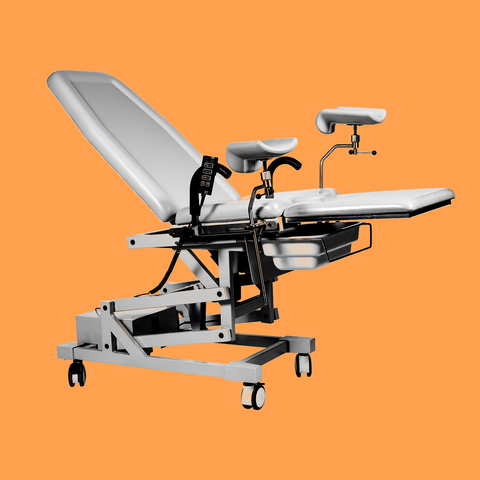When she tries to remember the feeling, she thinks of Drew*, a grad student with golden hair she dated in her mid-20s. He’d bound down the stairs to her basement apartment carrying tiny chocolate frogs for her; hours later, they’d fall asleep in her bed with their lips still touching, a messy tangle of sheets and limbs. Drew liked to touch the spot where her legs met her butt—and she loved to let him. She was so hypersexual that sometimes just tilting her hips into him, even fully clothed, could trigger that intense pulse-pulse-pulse deep inside her. That wild flurry of contractions that felt like every cell in her body was lighting up and regenerating. It felt, she thought, like magic.
Then it was August 2010. Her gyno was brusque, businesslike. Sasha* entered the small room with cold fluorescent lights and put her feet in the stirrups. She was a little nervous, but the doctor had said that a loop electrosurgical excisional procedure, or LEEP, would rid her cervix of the irregular cells that had been detected by her recent Pap smear and some follow-up tests. Thanks to a shot of anesthesia, Sasha felt nothing as a small heated wire was inserted into her vagina. The whole thing was over in minutes.
Walking home afterward, she had a hazy premonition that something was wrong, but she brushed it off—even when, for days, it almost felt like there was a part missing inside her body, a kind of hole where something important used to be.
It wasn’t until a few weeks later that a nice-looking guy approached Sasha at a bar. On their third date, she brought him back to her place. They were making out, entangled on her bed, when she tilted her hips into him—and nothing happened.
Confused, Sasha tried again, crunching her body against his, searching for the tingle that had often signaled the early sensations of orgasm. Instead, “I felt nothing,” she recalls. She continued going through the motions, but her mind was elsewhere, working itself into a panic over the numbness in her pelvis.
After the guy left, she reached down to touch herself like she had roughly once a day since she was 8 or 9 years old. But the soft, once-sensitive spot between her labia felt numb and dry. “You know that game where you put coins in the slot and a claw comes down to try and grab a teddy bear, but it can never grasp it?” Sasha asks. “That’s how it felt. There was a sort of sensation in my clitoral area, but just as I was about to orgasm, it was suddenly nothing.”
“I knew then,” she says. “Holy shit, they broke me.”
The quick simplicity of a LEEP belies its role in medicine’s triumph over a deadly disease.
In the 1950s, cervical cancer was a leading cause of cancer deaths for American women (it still kills more than 260,000 people a year in developing countries). Now, it’s almost completely preventable, says Linda Nicoll, MD, a gyno at NYU Langone Health.
This is largely because of better screening techniques and the HPV vaccine, which protects against the riskiest strains of the STI that causes most cervical cancers. But treatments like LEEP also played a role. The procedure, first performed in the U.S. in 1990, is like a second line of defense, excising cells that may otherwise lead to cancer. It’s fast—a doctor slices into the cervix and scoops out sketchy tissue, the same way you might cut a bruise out of an apple. And it usually works.
It’s also super common. Up to one million women in the U.S. are diagnosed every year with abnormal cervical cells, or what MDs call cervical dysplasia. Not all cases are high risk, but if doctors feel the precancerous spots need to be removed, LEEP is the most popular treatment. Because it’s so simple, it flies under the radar: No one knows exactly how many are done each year, since they’re considered as minor as, say, having a skin tag cut off, says Noah Goldman, MD, a gynecologic oncologist at Rutgers New Jersey Medical School. (“You’d never know how many people have skin tags removed,” he explains, “because most doctors just say, ‘Oh, I’ll numb it up and take it off for you.’”)
There are other ways to get rid of suspicious cervical cells, including freezing them off with cryotherapy and using a scalpel to cut them out. But doctors love LEEP because it’s so easy to perform. It’s also considered safe, with seemingly straightforward side effects like bleeding and discharge and an increased risk of pregnancy complications.
Except that Sasha—and hundreds of others—insist that it carries a devastating risk their doctors never mentioned. In a Facebook group called Healing From LEEP/LLETZ (LLETZ is the term used overseas), women share how LEEPs radically altered their sex lives, how penetrative sex is now painful, how they’ve lost sensation in their vaginas, how they could now go the rest of their lives without sex. “I haven’t reached orgasm since the operation,” wrote one woman. “I miss my old self, who burned with lust during sex.”
Emily, 25, says she felt nothing the first time she had sex after her LEEP last year.
“Normally it’s not difficult for me to orgasm, but it was like I wasn’t even having sex,” she says. “The guy I was dating was inside me and I couldn’t feel it.” She could still orgasm from clitoral stimulation, but even then, she experienced “contraction-like pain” in her lower abdomen. Months later, some sensation has returned to her vagina, but she still feels stabbing pain on her cervix during penetrative sex.
Gynecologists would seem like the most sympathetic allies for women claiming that their ability to orgasm has been cut out of their bodies. Unfortunately, the mechanics of sexual pleasure are barely taught in medical school. “The average gynecologist knows very little about sexual function,” says Andrew Goldstein, MD, an ob-gyn in Washington, D.C., who performs LEEPs in developing countries. “I guarantee they couldn’t tell you the nerves that go to the cervix.” Plus, many gynecologists resist blaming these symptoms on a procedure that can save lives.
And the research just isn’t there: Studies on LEEPs mostly focus on cancer prevention or pregnancy complications. A 2010 one out of Thailand did find a small but statistically significant decrease in overall sexual satisfaction after a LEEP, and an Italian study that same year showed a loss of sexual desire. But both concluded that the cause is likely psychological versus the result of damage to the cervix. In 2015, a review in the American Journal of Obstetrics & Gynecology suggested that LEEPs can affect sexual function…but that more research is needed.
Without strong evidence to back them up, several women Cosmo spoke to say they face an endless procession of doctors who don’t believe that their sexual dysfunction could be caused by the procedure. And the trauma of being disbelieved only compounds, for them, the trauma of feeling that an essential part of them has been irreparably damaged. No one gave them another option. Instead, to stay alive, Sasha, Emily, and the others had to give up one of the things that makes life worth living.
In February 2011, Sasha went back to her doctor.
She’d hung out with a couple of other guys by then, but most flings flamed out before even progressing into the bedroom. The loss of her once-vibrant sexuality deflated her confidence. Alone at home, she kept trying to touch herself, but stroking inside her vagina felt about as sexy as touching her elbow.
Sasha struggled to describe what had happened. “Something is terribly wrong,” she said. “I can’t feel sex.” Her MD jotted down “low libido” and asked, “Anything else?” Before Sasha could argue that she wanted to have sex, she just couldn’t enjoy it, she was rushed out.
Feeling dazed and invisible, Sasha booked an appointment with a new gyno who did a speculum exam and told her that her cervix had healed nicely from her LEEP and “looked fine.” When Sasha insisted that she did not feel fine, she was referred to a psychologist.
She spent the next two years in a maddening cycle of referrals: General practitioners sent her to gynecologists who sent her to therapists who sent her to psychiatrists. With each appointment came the hope that someone might validate her suspicions—and debilitating disappointment when they didn’t. “It’s dystopian to speak to so many doctors and have them not believe you,” she says.
It was five years after her LEEP that a trauma therapist finally referred her to Irwin Goldstein (no relation to Andrew), MD, the director of San Diego Sexual Medicine. By then, Sasha’s life had fallen apart. She’d lost touch with friends as they became annoyed by her fixation on her cervix. She’d still occasionally try hooking up with people, but it was always unsatisfactory, reinforcing her fears about the brokenness of her body. She’d even quit her job as an accessories designer, too depressed to work. “I remember spending a lot of money on vibrators and lubricants,” she says. Sometimes, mashing her clitoris like a button, she could eke out a vague clitoral orgasm—a tiny, disengaged fraction of what she had experienced before.
Increasingly desperate for answers, Sasha booked a flight to San Diego for an appointment with Dr. Goldstein. In his exam room, for the first time, she finally found someone who believed her. After previous patients had complained about LEEPs, Dr. Goldstein referenced a pioneering 2004 study led by Rutgers neuroscientist Barry Komisaruk, PhD, to theorize that some LEEPs cut too deeply into the cervix and sever vital nerve endings, silencing the genital connection to the brain. Komisaruk now speculates this could even have a numbing effect on the entire area, similar to the way nerves degenerate in the general area around an amputated limb. Simply put: A too-aggressive LEEP might scoop out a woman’s cancer risk—but also some or all of her sexual feeling.
“Nobody teaches doctors or does quality control on how deep to go,” says Dr. Goldstein. “There is no appreciation for the three very important nerves in the cervix…and that the deeper you go, the higher your chance of denervating the whole thing.”
He ran tests, including using a device to place increasing pressure against Sasha’s cervix—and she could barely feel it. This confirmed, he told her, that her nerves had been damaged by her LEEP. She was overcome with bittersweet relief. “I wanted him to fix me,” she says, “and I knew he couldn’t, because you can’t just go in and magically fix broken nerves.”
Still, the validation allowed her to do something her years-long search for answers never did: try to move on with her life. Shortly after her trip to San Diego, she contacted a sperm bank and, in March of this year, found out she was pregnant. She now smiles when she talks about feeling her baby kick. It feels, she says, like hope—like evidence that her body may yet be capable of magic.
When Dr. Irwin Goldstein presents his theory at medical conferences, it tends not to go well.
“It’s shocking how defensive the gynecological community gets. They say, ‘I’ve never seen this. You’re making this up.’ Yet there are entire groups of women who’ve had LEEPs who have problems.”
Much of Dr. Goldstein’s research is considered “controversial,” says Tami Rowen, MD, an ob-gyn at the University of California San Francisco Medical Center. Or as Dr. Andrew Goldstein puts it: “Dying from cervical cancer is horrific. We can write about how
the treatment affects orgasms or we can write about how it saves millions of lives.” (He clarifies that he doesn’t want to downplay the sexual ramifications of LEEPs, and that doctors should not perform the procedure too “aggressively.”)
In the field of urology, doctors regularly discuss the possible sexual side effects of surgery on the male reproductive organs—and Dr. Irwin Goldstein says this should happen in gynecology too: “An era has to come when we accept that there are risks to operating on the cervix.”
Of course, doctors brushing off women’s sexuality is nothing new. In 1978, the International Society for Sexual Medicine was established…and focused on men. Four years later, the first nerve-sparing prostatectomy was performed to treat prostate cancer without causing permanent sexual dysfunction. The groundbreaking technique was possible thanks to decades of research on the prostate and penis, says Arthur Burnett, MD, a urologist at Johns Hopkins Medicine.
Similar research on women has lagged way behind, says James Simon, MD, president of the International Society for the Study of Women’s Sexual Health. This means women often report experiencing sexual symptoms years or even decades before they show up in medical journals. (Dr. Rowen uses the example of the birth control pill, whose sexual side effects were once routinely dismissed by doctors.) Like Sasha, they find themselves caught in the agonizing gap between their experience and published science.
Dr. Irwin Goldstein and Komisaruk are trying to remedy this, collaborating with a team that is dissecting cervixes removed during hysterectomies to determine the exact location of the three cervical nerves identified by Komisaruk. Through their research, they hope to help gynecologists acknowledge these nerves and perform more precise LEEPs in the future.
In the meantime, some doctors are exploring other options. Dr. Rowen hasn’t had patients complain about sex after a LEEP, but she routinely uses cryotherapy instead, since it’s similarly effective at slashing cancer risk without cutting into the cervix (although even this is considered somewhat controversial among gynecologists and pathologists, who often want to see the clean borders a LEEP provides). “If people believe LEEPs cause sexual dysfunction—and I think there’s evidence to show it does—women should at least be told there’s a risk,” she says.
For women already left sexually damaged, the search for orgasm continues.
Emily still can’t have sex on top without pain. Michelle, 36, who had satisfying sex nearly every day before her LEEP, now says, “I just have to enjoy everything that goes along with sex, like satisfying my partner, and not be upset that I can’t orgasm. Because it’s just not going to happen.”
When she complained to her doctor, he suggested she switch the birth control she’s been on for several years. After her new insurance kicks in, she plans to see a new gyno.
*Name has been changed.
















